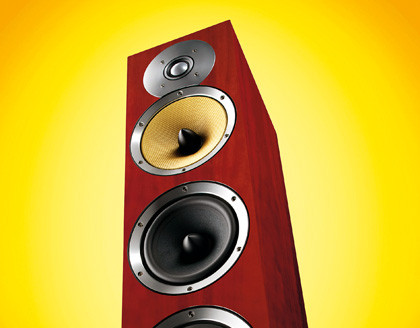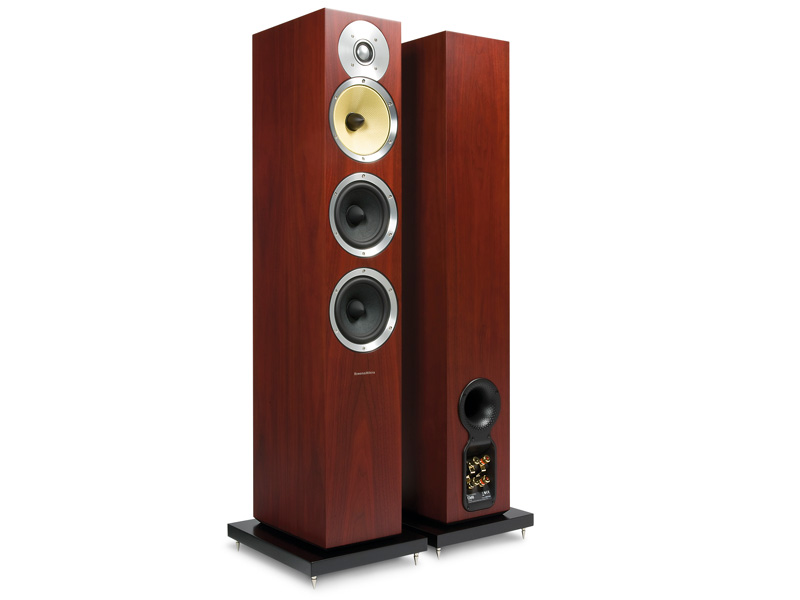TechRadar Verdict
Pros
- +
Superior midband
- +
Fine imaging
- +
Wide dynamic range
Cons
- -
Bottom end lacks convincing grip, drive and authority
Why you can trust TechRadar
Bowers and Wilkins currently has four main ranges of hi-fi speakers: the budget-priced 600 series; the super-slim, metal-jacket XTs, the upmarket 800 Diamonds and the CM-series, one of which (the sensibly priced CM8) is exclusive to Hi-Fi Choice this month.
You may recall that we reviewed the Bowers and Wilkins CM9, the larger of the floorstanders, and while it is is clearly good material value for money – significantly bigger in both cabinet size and driver area – it was also arguably rather too large for our 4.3x2.6x5.5m room, delivering a bit too much bass output when the effects of room gain were added to the substantial bass output of a stereo pair.
The good news is, however, that the CM-series has evolved significantly down the years. As a world leader in hi-fi loudspeakers, Bowers and Wilkins is definitely a pacesetter in driving the market forward and it has a clever ability to find and create niches within the overall loudspeaker scheme of things and build appropriate models to suit.
New models are continually replacing earlier ones in order to introduce engineering and styling improvements. So, with the memory of the cabinet size and substantial bass of the previously mentioned CM9 fresh in our minds, we were naturally very enthusiastic when the company announced the more petite CM8.
Instead of two 165mm bass drivers, for example, it uses two smaller 130mm units and that use of smaller bass drivers also permits a slimmer, more compact and consequently more attractive and domestically acceptable enclosure.

As is usually (though not entirely logically) the case, this smaller model is also considerably less costly at £1,250 per pair, against £1,800 per pair for the CM9.
The slim advantage
Sign up for breaking news, reviews, opinion, top tech deals, and more.
Whereas the CM9 rather looks like a bit of a bruiser, perhaps best chosen by those with large rooms and/or a penchant for heavy rock, the CM8 is an exceptionally elegant package.
The very slim, sharp-edged and surprisingly hefty and solid enclosure comes dressed in a choice of two fairly dark real-wood veneers (wenge and rosenut), with painted options in white and high-gloss black. A moulded frame grille attaches via concealed magnets, so there are no unsightly mounting lugs if it's left in the carton.
Omitting the grille normally adds a little to the sound quality and also here reveals a considerable amount of shiny silver bling surrounding each of the four drivers. Regrettably, however, the metal tweeter dome diaphragm is left entirely unprotected (except during transit) and is, therefore, very vulnerable – especially to inquisitive tiny fingers, who tend to regard a shiny silver 'button' as something that's crying out to be pressed.
Said 25mm tweeter has a shiny silver faceplate with a cut-out segment that allows its diaphragm to be closer to the midrange unit as would otherwise be the case. Because the small diameter drivers allow the enclosure to be unusually slim, it's possible to view the CM8 as a little like a CM1 with a built-in passive subwoofer.
However, it differs in using an FST-type driver (see Talking Point) in place of a bass/mid drive unit. Since an FST is designed for minimal cone excursion, it therefore only performs midrange duties, a fact which necessitates a separate bass-only section.
Driver bang for your buck
The two bass drivers are reflex-loaded by most of the enclosure's internal volume and a port located low down at the rear. Left open, this port is tuned to around 37Hz, but Bowers and Wilkins also supplies a two-piece foam bung.
Inserting the whole bung virtually blocks the port and effectively re-tunes the enclosure to sealed-box operation (with the drivers/box resonance at 53Hz), reducing bass output. This option is likely to work best if the speakers have to be located fairly close to a wall. The 'half-bung' option, removing a foam cylinder from the centre of the bung and leaving just a foam sleeve, re-tunes the port to around 28Hz.
Just below the port sits a standard-moulded terminal block with two pairs of terminals. The speaker was supplied with these linked by brass strips, which may be removed to make bi-wire or bi-amp connection.
Underneath the whole speaker, a plain but unquestionably effective plinth bolts to the base of the tower providing secure spike accommodation, improved physical stability (presumably to meet the EC 'topple' test), and also enhancing the overall appearance.
Getting connected
It was, perhaps, a trifle unfortunate that the CM8s arrived during a period when the very much bigger and significantly more costly 800 Diamonds were still residence in the listening room!
The 800s intimidating presence led you to surmise that perhaps the little pipsqueaks didn't stand much of a chance. And yet, while there was no denying the significant superiority of its bigger brother, the CM8 by no means disgraced itself in comparison.
That said, it took a little time to find the best location and port tuning for the CM8s. When the port is completely open and the speakers positioned well clear of walls, the bass region as a whole sounds a little too dominant.

Sleeving the port undoubtedly helps somewhat, though the most even bass delivery is actually achieved with the ports completely blocked and the speakers located about 25cms out from the wall.
In the end, that 25cm spacing seems to give the best overall results, but it's really a matter of personal preference, whether to block the port completely or leave just the sleeve in place.
The speakers were mostly driven from a system comprising a Naim NAC552 preamp, with NAP500 power amp, driven from Naim CDS3/555PS, Rega valve Isis CD players and a Magnum Dynalab MD106T FM tuner. Vinyl replay was supplied via a Linn/Rega hybrid record player, with a Soundsmith Strain Gauge cartridge. Cables included examples from Naim, Phonosophie, The Chord Company, TM Systems and Vertex AQ.
The ear test
While the CM8 is neither the liveliest nor the smoothest speaker around, it is fundamentally very well balanced overall and delivers ample deep bass alongside an impressively wide dynamic range.
The latter has much to do with the solidity of the enclosure here, assisted by the stability of the plinth, both helping provide a firm, substantial and stable 'mechanical earth' against which the driver diaphragms can operate. That same very solid build, not only helps minimise cabinet coloration and maximise the dynamic range, it also plays an important role in helping to create very fine out-of-the-box stereo imaging.
The other key factor that plays a part here is the unusually narrow enclosure, which helps to ensure tight image focus. Add in the observation that both timing and overall coherence are also very good, and you have a recipe that also adds a measure of transparency to the soundstage, ensuring decent depth perspectives.
Furthermore, the consistently wide dispersion helps maintain good correspondence between the axial and the integrated power responses. The midrange is certainly the CM8's greatest strength, combining smoothness, evenness and considerable delicacy, so that human voices are both believable and expressive.
It has become something of a Bowers and Wilkins tradition to incorporate a degree of restraint through the presence zone. When taken to extremes this may lead to a rather 'shut-in' character, but that isn't the case here. While the speaker does indeed show a modicum of restraint and certainly doesn't sound 'upfront' or 'in yer face', the top end sound balance is actually quite bright and this provides more than ample compensation for low-level listening.
Indeed, the sound can actually tend to become a little aggressive if the volume is turned up high. While the midrange is its strongest point, the top end is also quite smooth and well ordered, if rather less sweet than the best. It certainly behaves very well, but does have a tendency to draw a little too much attention to itself and can also contribute to the slightly aggressive tendency when the volume is turned up high.
However, the bass end of things doesn't really measure up to the performance higher up the band. It's not so much that there's any shortage of bass extension or relative loudness, rather that it lacks a little poise, a sense of purpose and any serious authority and grip. It hangs on in OK, but doesn't really drive the music along in the way a larger, more powerful (and costly) speaker can.
This matters little with much of the material that's around, but certain tracks and albums where the bass effectively takes the lead, can prove a significant disappointment. Playing Massive Attack's Mezzanine, for example, especially the standout track Inertia Creeps, which uses several instruments through the bass region, it was quite difficult to distinguish the separate parts. Furthermore, the rather limp and vague bass delivery lacks the grip and momentum needed to bring the music properly to life and provide it with sort of tension and sense of drive that's essential in conveying the menace inherent in this track.
Associated with the relatively weak discrimination through the bass region, dynamic expression is also a little lacking, though not unreasonably so in view of the driver complement and price point. Indeed, within the inevitable constraints imposed by its price, the CM8 does a pretty impressive job and if its low frequency performance is a weakness, quite the opposite is true of the imaging, which is precise, beautifully focused and entirely free from any boxiness.
Interestingly, although this isn't a particularly tall loudspeaker, it's well able to create height as well as depth in the stereo soundstage. However, the bottom line, at least as far as most potential customers will be concerned, is that this is an exceptionally attractive-looking loudspeaker, well-suited to British rooms and selling at a very realistic price.
Follow TechRadar Reviews on Twitter: http://twitter.com/techradarreview
